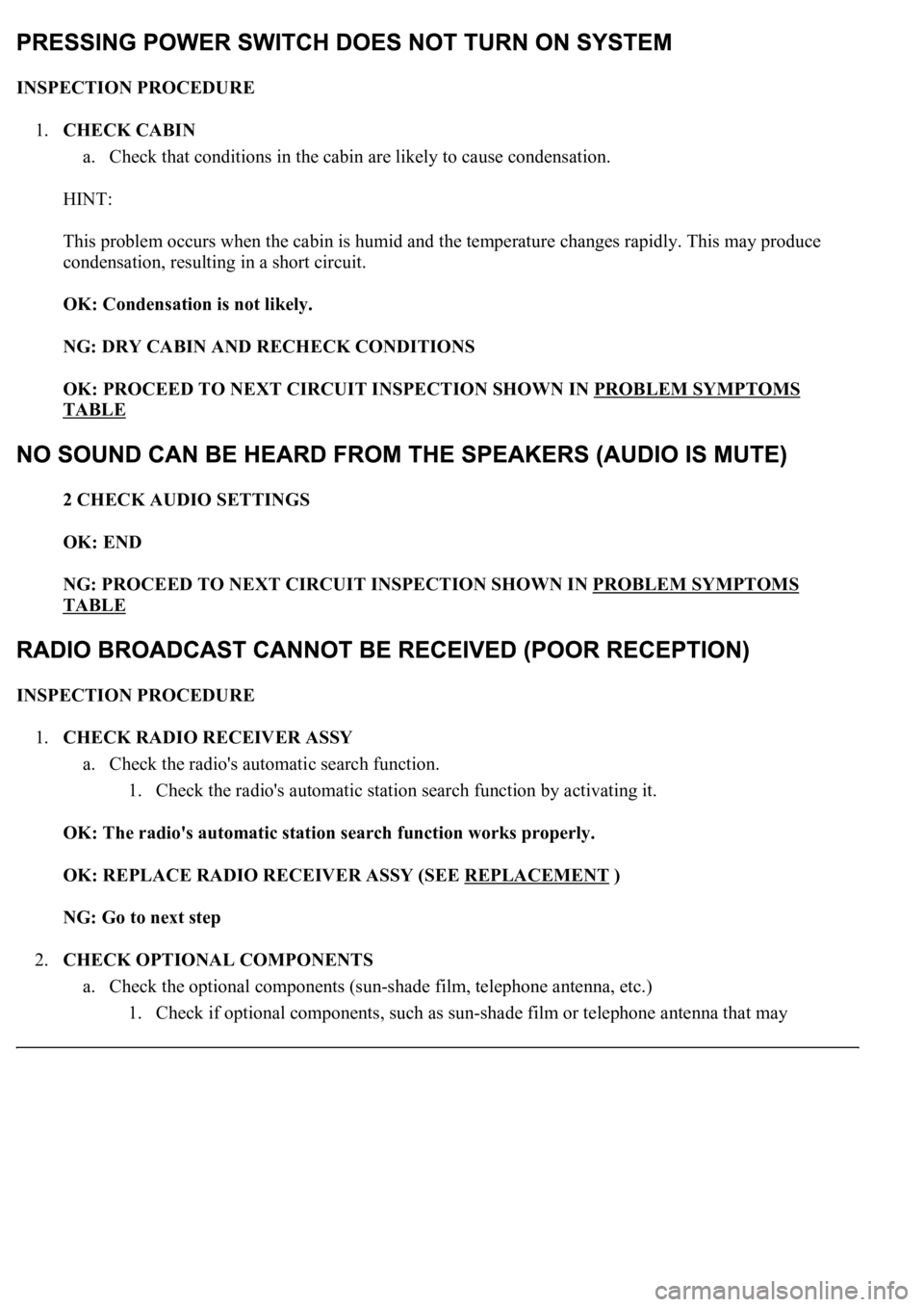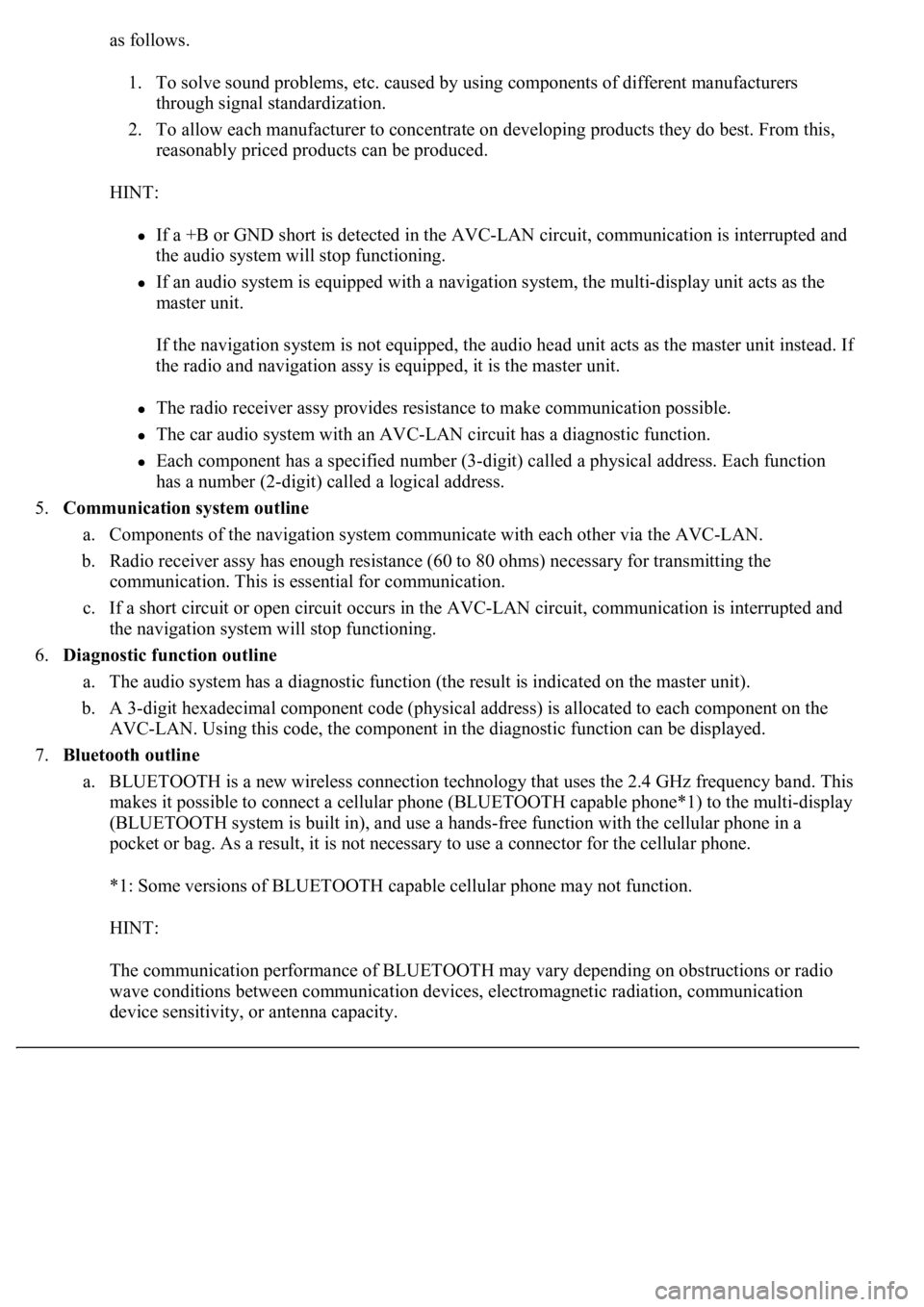Page 743 of 4500

INSPECTION PROCEDURE
1.CHECK CABIN
a. Check that conditions in the cabin are likely to cause condensation.
HINT:
This problem occurs when the cabin is humid and the temperature changes rapidly. This may produce
condensation, resulting in a short circuit.
OK: Condensation is not likely.
NG: DRY CABIN AND RECHECK CONDITIONS
OK: PROCEED TO NEXT CIRCUIT INSPECTION SHOWN IN PROBLEM SYMPTOMS
TABLE
2 CHECK AUDIO SETTINGS
OK: END
NG: PROCEED TO NEXT CIRCUIT INSPECTION SHOWN IN PROBLEM SYMPTOMS
TABLE
INSPECTION PROCEDURE
1.CHECK RADIO RECEIVER ASSY
a. Check the radio's automatic search function.
1. Check the radio's automatic station search function by activating it.
OK: The radio's automatic station search function works properly.
OK: REPLACE RADIO RECEIVER ASSY (SEE REPLACEMENT
)
NG: Go to next step
2.CHECK OPTIONAL COMPONENTS
a. Check the optional components (sun-shade film, telephone antenna, etc.)
1. Check if optional components, such as sun-shade film or telephone antenna that ma
y
Page 744 of 4500
decrease reception capacity, are installed.
OK: Optional components are installed.
OK: REMOVE OPTIONAL COMPONENTS AND CHECK AGAIN
NG: Go to next step
3.CHECK THE ANTENNA
a. Check the antenna for noise.
1. Turn the ignition switch to the ACC position, turn the radio on, and put the radio into AM
mode.
Contact the tip of a screwdriver on the antenna assy and check that noise can be heard from the speaker.
OK: Noise is heard from the speaker.
OK: REPAIR ANTENNA ASSY (SEE REPLACEMENT
)
NG: Go to next step
4.CHECK RADIO RECEIVER ASSY
a. Preparation for check
1. Remove the antenna plug from the radio receiver assy.
b. Check for noise
Page 745 of 4500
<0029004c004a0011000300160019001d000300350048005000520059004c0051004a0003002400510057004800510051004400030033004f0058004a000300290055005200500003003500440047004c005200030035004800460048004c00590048005500
03002400560056005c[
Courtesy of TOYOTA MOTOR SALES, U.S.A., INC.
1. Turn the ignition switch to the ACC position with the radio receiver assy connector
connected.
2. Turn the radio on and put into AM mode.
3. Contacting a flat head screwdriver, thin wire, or other metal object against the radio
receiver's antenna jack, check that noise can be heard from the speaker.
OK: Noise occurs.
NG: REPLACE RADIO RECEIVER ASSY (SEE REPLACEMENT
)
OK: Go to next step
PROCEED TO NEXT CIRCUIT INSPECTION SHOWN IN PROBLEM SYMPTOMS TABLE
INSPECTION PROCEDURE
Page 749 of 4500

NG: REPLACE THE CD
OK: Go to next step
3.CHECK RADIO RECEIVER ASSY
a. Insert another CD and check if it is ejected.
OK: The disc is ejected.
NG: REPLACE RADIO RECEIVER ASSY (SEE REPLACEMENT
)
OK: NORMAL OPERATION
INSPECTION PROCEDURE
1.CHECK SPEAKERS
a. Check the speaker unit installed condition.
1. Check that each speaker is securely installed.
OK: The problem goes away.
HINT:
The radio has a noise prevention function to reduce noise when listening to the radio. If a loud noise
occurs, check whether the ground at the antenna mounting base and the noise prevention unit are installed
and wired correctly.
NOISE CONDITION CHART
Noise ConditionsNoise Source
Depressing the accelerator pedal makes the noise louder. However, the noise
stops immediately when the engine is stopped.Alternator
Noise occurs while the A/C or heater is in operation.Blower motor
Noise can be heard during sudden acceleration on an unpaved road, or after the
ignition switch is turned ON.Fuel pump
Noise can be heard when the horn is pressed and released, or held down
continuously.Horn
<00340058004c00480057000300510052004c0056004800030046004400510003004500480003004b00480044005500470003005a004b004c004f004800030057004b0048000300480051004a004c0051004800030055005800510056000f00030045005800
570003005600570052005300560003005a004b004800510003[the engine is
stopped.Ignition
Noise can be heard when the turn signal blinks.Flasher
Noise can be heard while window washer is in operation.Washer
Noise can be heard while the engine is running and continues after it is stopped.Water temperature
sensor
Noise can be heard while the wiper system is in operation.Wiper
Page 4449 of 4500

as follows.
1. To solve sound problems, etc. caused by using components of different manufacturers
through signal standardization.
2. To allow each manufacturer to concentrate on developing products they do best. From this,
reasonably priced products can be produced.
HINT:
If a +B or GND short is detected in the AVC-LAN circuit, communication is interrupted and
the audio system will stop functioning.
If an audio system is equipped with a navigation system, the multi-display unit acts as the
master unit.
If the navigation system is not equipped, the audio head unit acts as the master unit instead. I
f
the radio and navigation assy is equipped, it is the master unit.
The radio receiver assy provides resistance to make communication possible.
The car audio system with an AVC-LAN circuit has a diagnostic function.
Each component has a specified number (3-digit) called a physical address. Each function
has a number (2-digit) called a logical address.
5.Communication system outline
a. Components of the navigation system communicate with each other via the AVC-LAN.
b. Radio receiver assy has enough resistance (60 to 80 ohms) necessary for transmitting the
communication. This is essential for communication.
c. If a short circuit or open circuit occurs in the AVC-LAN circuit, communication is interrupted and
the navigation system will stop functioning.
6.Diagnostic function outline
a. The audio system has a diagnostic function (the result is indicated on the master unit).
b. A 3-digit hexadecimal component code (physical address) is allocated to each component on the
AVC-LAN. Using this code, the component in the diagnostic function can be displayed.
7.Bluetooth outline
a. BLUETOOTH is a new wireless connection technology that uses the 2.4 GHz frequency band. This
makes it possible to connect a cellular phone (BLUETOOTH capable phone*1) to the multi-display
(BLUETOOTH system is built in), and use a hands-free function with the cellular phone in a
pocket or bag. As a result, it is not necessary to use a connector for the cellular phone.
*1: Some versions of BLUETOOTH capable cellular phone may not function.
HINT:
The communication performance of BLUETOOTH may vary depending on obstructions or radio
wave conditions between communication devices, electromagnetic radiation, communication
device sensitivit
y, or antenna capacity.